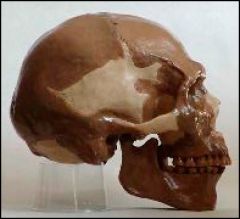Grade Level(s):
- 9-12
- 13-16
Source:
- ENSI
Resource type:
- Classroom activity
Time: One to two class periods
Overview
Students describe, measure and compare cranial casts from contemporary apes, modern humans, and fossil hominids to discover some of the similarities and differences between these forms and to see the pattern leading to modern humans.

- [Evidence of evolution: Grades 9-12] An organism's features reflect its evolutionary history.
- [Evidence of evolution: Grades 9-12] The fossil record contains organisms with transitional features.
- [Evidence of evolution: Grades 9-12] Similarities among existing organisms provide evidence for evolution. (LS4.A)
- [Evidence of evolution: Grades 9-12] Anatomical similarities of living things reflect common ancestry. (LS4.A)
- [Evidence of evolution: Grades 13-16] An organism's features reflect its evolutionary history.
- [Evidence of evolution: Grades 13-16] The fossil record provides evidence for evolution.
- [Evidence of evolution: Grades 13-16] The fossil record contains organisms with transitional features.
- [Evidence of evolution: Grades 13-16] Similarities among existing organisms (including morphological, developmental, and molecular similarities) reflect common ancestry and provide evidence for evolution.
- [Mechanisms of evolution: Grades 13-16] Evolution does not consist of progress in any particular direction.
- [Nature of science: Grades 9-12] A hallmark of science is exposing ideas to testing. (P3, P4, P6, P7)
- [Nature of science: Grades 9-12] Scientists can test ideas about events and processes long past, very distant, and not directly observable.
- [Nature of science: Grades 13-16] A hallmark of science is exposing ideas to testing.
- [Studying evolution: Grades 9-12] Scientists use the similarity of DNA nucleotide sequences to infer the relatedness of taxa. (LS4.A)
- [Studying evolution: Grades 9-12] Scientists use fossils (including sequences of fossils showing gradual change over time) to learn about past life.
- [Studying evolution: Grades 13-16] Scientists use multiple lines of evidence (including morphological, developmental, and molecular evidence) to infer the relatedness of taxa.
- [Studying evolution: Grades 13-16] Scientists use fossils (including sequences of fossils showing gradual change over time) to learn about past life.
- Disciplinary Core Idea LS4.A: Evidence of Common Ancestry and Diversity
- Science and Engineering Practice 4. Analyzing and interpreting data
- Science and Engineering Practice 6. Constructing explanations and designing solutions
- Science and Engineering Practice 7. Engaging in argument from evidence
There are currently no teaching tips for this resource.
This resource currently lacks an associated teaching background.
